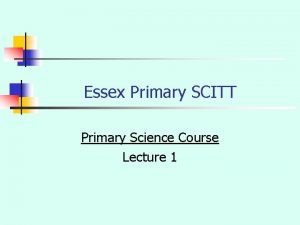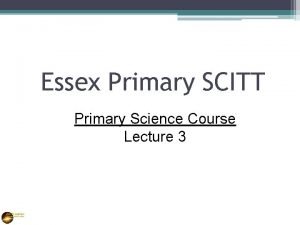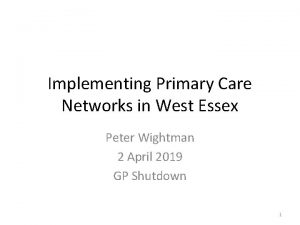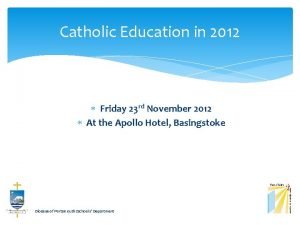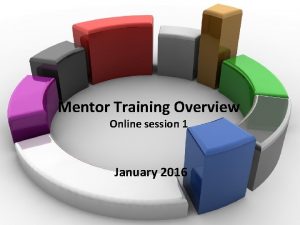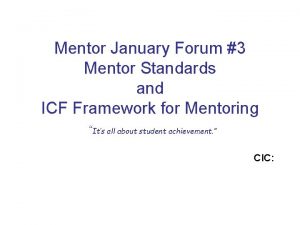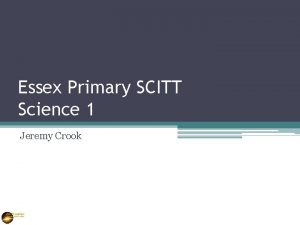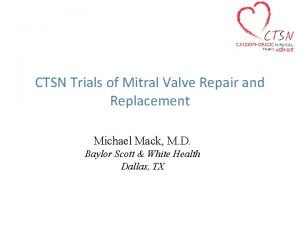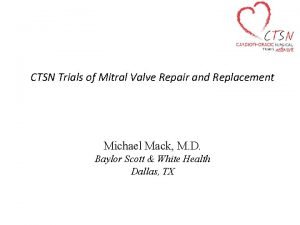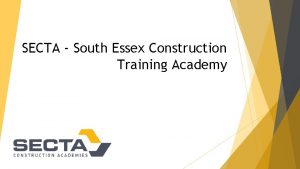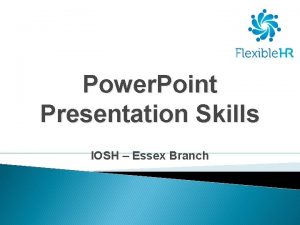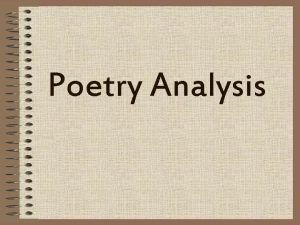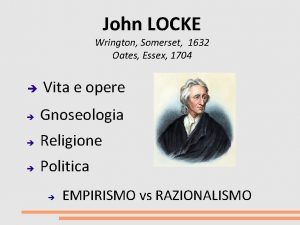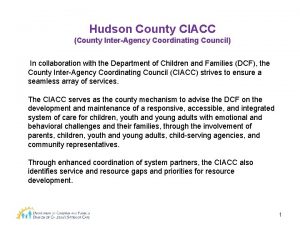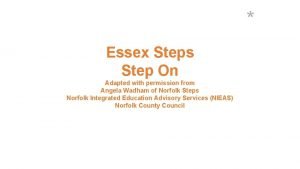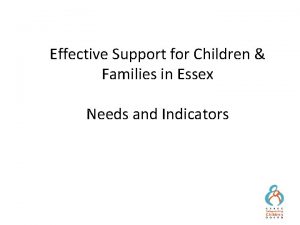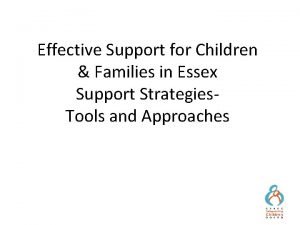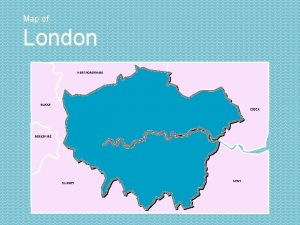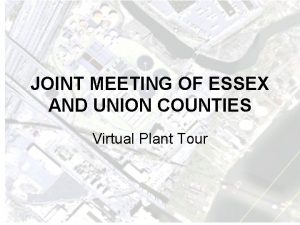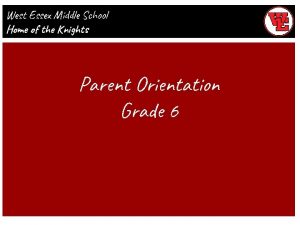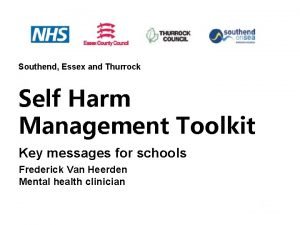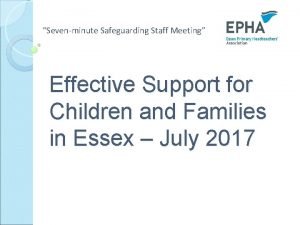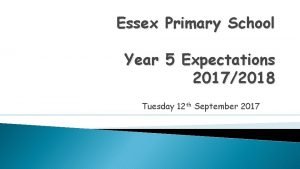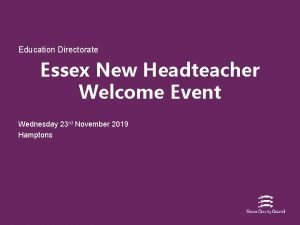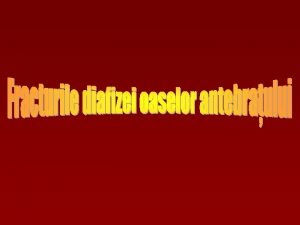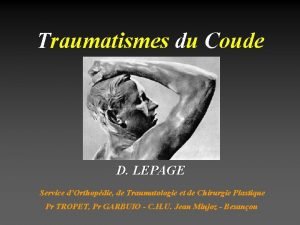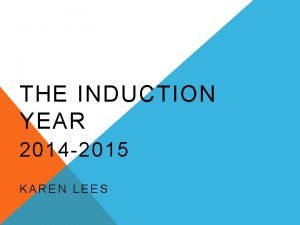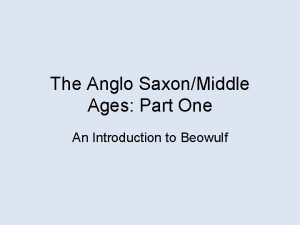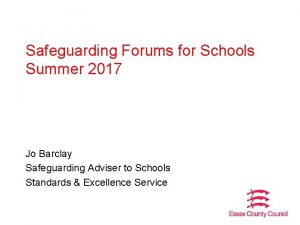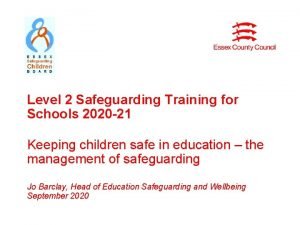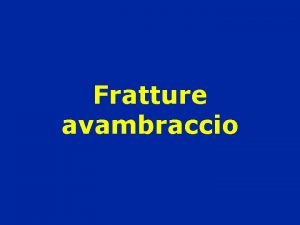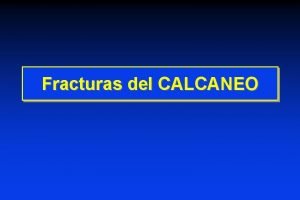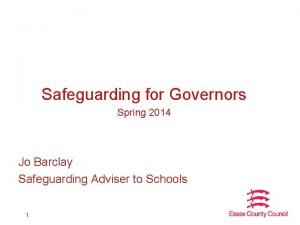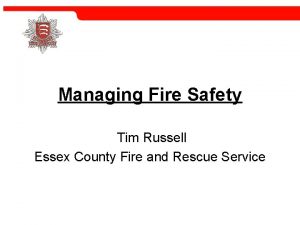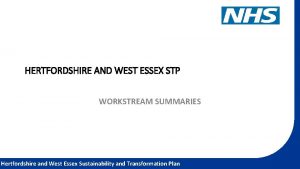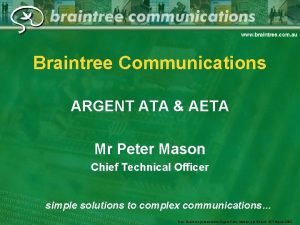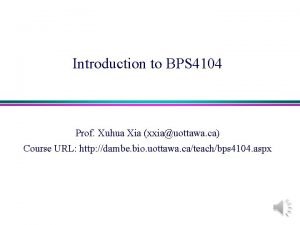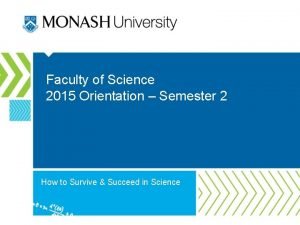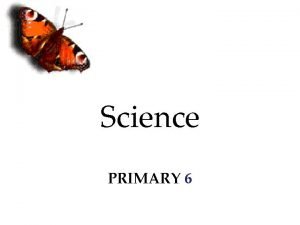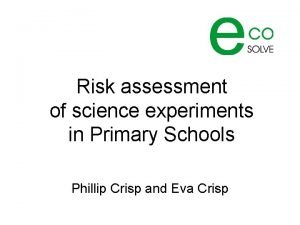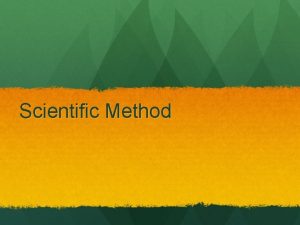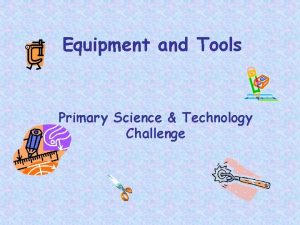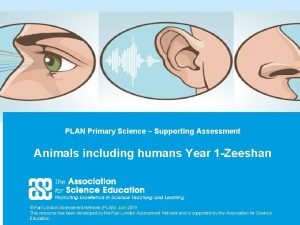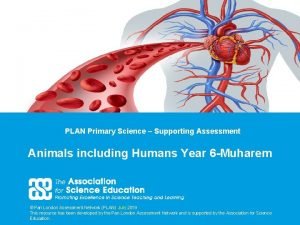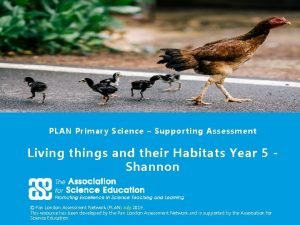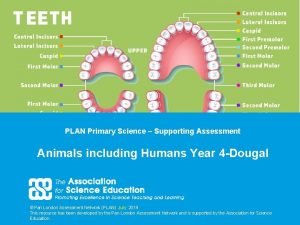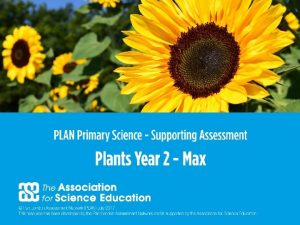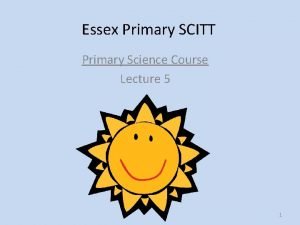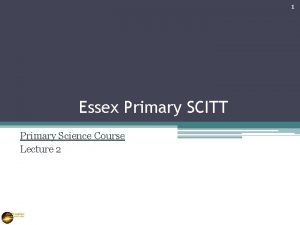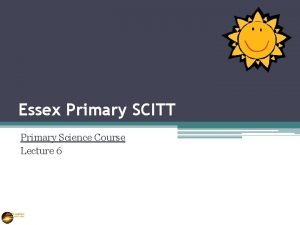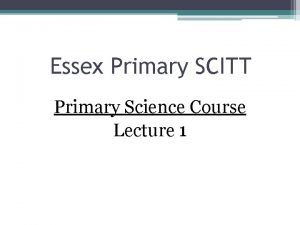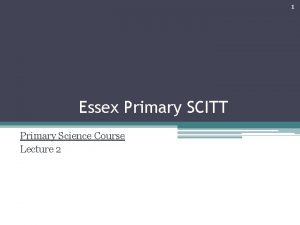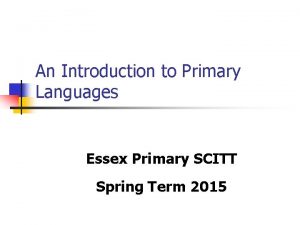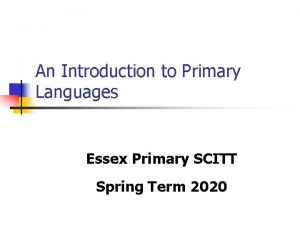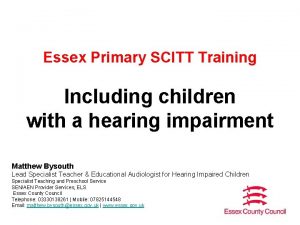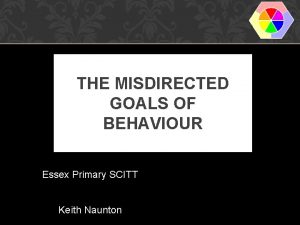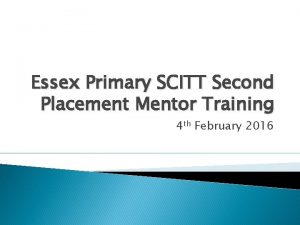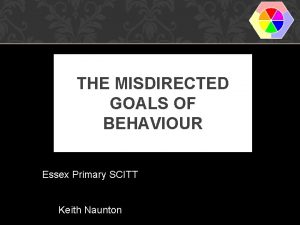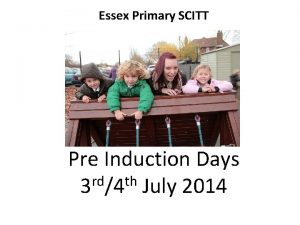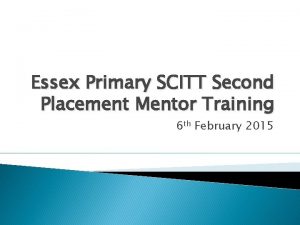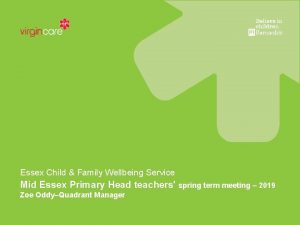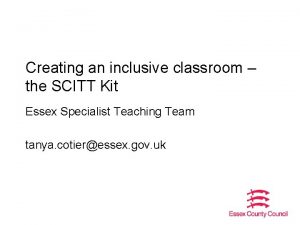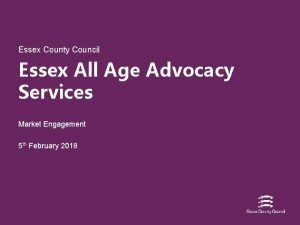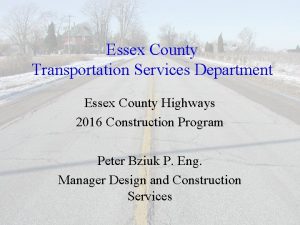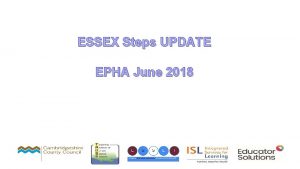Essex Primary SCITT Primary Science Course Lecture 4






















































































- Slides: 86

Essex Primary SCITT Primary Science Course Lecture 4

Review of last time Develop trainees’ knowledge and understanding of the concept of forces, including: o Magnetic o Friction, including air resistance o Gravitational Consider the elements to be included in an effective science lesson. Develop trainees’ knowledge and understanding of the scientific enquiry skills of fair testing and recording, including the use of tables, the drawing of graphs and evaluating results.

Feedback from last time • • • Lesson plans and ideas could be taken further. How important was the task? Did we need to discuss it more? Could have made everyone a cup of coffee! Day felt a bit upside down as no children to teach. Scaffolding and assessment would have had a context after watching the teaching. Assessment information is necessary but struggled to stay engaged – would have been better to have slide info separate so I could read the text and annotate. Understand the reason why you didn’t have much notice. Make (assessment) slides bigger so you can read them. More tips please (although there were plenty this time!) It was a brilliant day so the only thing that would have made it better was to see you teach! Get through all the slides to cover what we missed. More experiments please. Disappointing we couldn’t get everything done as it was a great day. Could we have more of your planning examples.

Early Years

Early Years Foundation Stage • This is the period from birth to 5 years old. • The Early Learning Goals (ELGs) set out what is expected for most children by the end of the foundation stage. • The term Early Learning is critical. Developing children as effective learners is the fundamental purpose of Reception classes. • In Reception classes there are trained teachers who understand the continuum from Early Years to National Curriculum learning and there is a sharp focus on progression in learning.

Science in the Early Years • http: //www. bigeyedowl. co. uk/science/ - A useful site that contains themed activities • http: //www. nationalstemcentre. org. uk/dl/afbfd 9 a 713 92045 c 9514 e 0 fda 765 bc 1 ce 95 c 0 f 41/18126 LAYING%20 THE%20 FOUNDATIONS%20 IN%20 THE%20 EARLY %20 YEARS. pdf - A very useful resource that gives a comprehensive explanation of how to implement science in the early years plus lots of ideas too. • https: //www. tes. com/teaching-resource/sensoryscience-6121831 - A useful little booklet with some interesting ideas.

Overarching principles • every child is a unique child, who is constantly learning and can be resilient, capable, confident and self-assured; • children learn to be strong and independent through positive relationships; • children learn and develop well in enabling environments, in which their experiences respond to their individual needs and there is a strong partnership between practitioners and parents and/or carers; and • children develop and learn in different ways and at different rates. The framework covers the education and care of all children in early years provision, including children with special educational needs and disabilities.

EYFS – Prime Areas • There are three prime areas (Language and communication, Physical development and Personal, social and emotional development) and four specific areas. • There are four specific areas, through which the three prime areas are strengthened and applied. The specific areas are: ▫ literacy; ▫ mathematics; ▫ understanding the world; and ▫ expressive arts and design.

Understanding the world • Understanding the World is made up of 3 areas: ▫ People and Communities ▫ The World ▫ Technology • Most scientific ideas are included in ‘The World’.

How learning is planned • On entry, children are assessed against their age. A child of 50 months assessed as ‘Age- Related’ would most likely be working within the 40 -60 months band then towards Early Learning Goals. • There are 5 statements for ‘The World’ in the 30 -50 month band only one statement within the 40 -60 month band three Early Learning Goal statements. • This proportion of statements is much lower than other areas of the EYFS Framework. • However, at this stage, children should learn and be taught how to be scientists and the Characteristics of Effective Learning are central to this.


Effective teaching and learning • There are three characteristics of effective teaching and learning in EYFS. These are: ▫ playing and exploring - children investigate and experience things, and ‘have a go’. ▫ active learning - children concentrate and keep on trying if they encounter difficulties, and enjoy achievements. ▫ creating and thinking critically - children have and develop their own ideas, make links between ideas, and develop strategies for doing things. Read ‘STEM in the Early Years’. What are the most important points made in the research?

What science should be done? § Foundation Stage science involves the following skills that must be explicitly taught. ▫ Asking questions and being curious about the world around them, why things happen and how things work. ▫ Finding out about, and identifying, some features of living things, objects and events they observe. ▫ Investigating objects and materials by using all of their senses (observing). ▫ Looking closely at similarities, differences, patterns and change.

Essential elements for young scientists I • Confident learners ▫ Provide familiar contexts when giving children: �The opportunity to investigate (development of thought) �The opportunity to communicate (development of language) • Independent learners Provide: ▫ opportunities to explore those things that are closest to them ▫ a stimulating learning environment ▫ access to inspiring resources

Essential elements for young scientists II • Clear framework for learning ▫ This needs to guide children in their play and provide opportunities for real life and imaginative investigative play • Sufficient time for learning in new situations ▫ Begin by using their existing knowledge and experience then extend this into new situations that challenge their skills and present problems to be solved

Adult intervention in children’s learning There are 3 layers of intervention to consider: 1. Observe – Do you need to intervene at all? What are children’s immediate needs? What are their ideas? Are the children self-challenging? Only consider intervention after asking yourself these questions. 2. Play alongside – This will often sustain their interest and will ensure children’s ownership of their learning is maintained, so they are interested in what they are learning not what the teacher thinks they should be learning. Model learning behaviours when you recognise barriers. 3. Questions – Develop children’s learning by stimulating their thinking and curiosity or to introduce a challenge. Questions will often be linked to key learning objectives.

Case study • Read ‘Reception case study – Santa’s Sleigh’. • Read ‘Essential strategies when teaching Early Years Science’. • Identify which elements contained in this article have been used and developed in the case study.

So remember … • Use children’s interests as the starting point for learning. • Create a rich environment that inspires children and motivates investigative learning. Resources should be accessible in order for children to revisit and master skills and concepts. • Set a framework for learning and provide time for children to investigate their own ideas. • Challenge and extend ideas through sustained shared thinking.

Electricity

ELECTRICITY - Safety first • TELL CHILDREN NEVER TO PLAY WITH ANY MAINS DEVICE OR ATTEMPT TO PLUG IN OR UNPLUG ANYTHING. • If someone touches a live mains wire (240 volts), electricity will flow through their body and they could be killed. • The small batteries we use at school (less than 10 volts) produce an electrical current of such low power we are unlikely to be able to feel it. • However, be aware of short circuits – see later.

What do children say? When the circuit is connected the bulb lights up, but why? i. ‘… because when you plug the bulb in it lights. ’ ii. ‘…because you’ve fastened the lead on the battery. ’ iii. ‘… because you’ve put the power on. ’ iv. ‘…electricity comes through here and here (pointing to both leads from the battery to the bulb) and lights it. ’ v. ‘…because the crocodile clip is metal and the bulb casing must be metal. ’ vi. ‘…because the electricity flows through the wires and makes it light. ’ vii. ‘…because the circuit’s right and so it lights up. ’

NC Year 4 : Electricity Pupils should be taught to: • identify common appliances that run on electricity • construct a simple series electrical circuit, identifying and naming its basic parts, including cells, wires, bulbs, switches and buzzers • identify whether or not a lamp will light in a simple series circuit, based on whether or not the lamp is part of a complete loop with a battery • recognise that a switch opens and closes a circuit and associate this with whether or not a lamp lights in a simple series circuit • recognise some common conductors and insulators, and associate metals with being good conductors.

Guidance notes… • Pupils should draw the circuit as a pictorial representation, not necessarily using conventional circuit symbols at this stage; these will be introduced in year 6. • Note: Pupils might use the terms current and voltage, but these should not be introduced or defined formally at this stage. • Pupils should be taught about precautions for working safely with electricity. • Pupils might work scientifically by: observing patterns, for example, that bulbs get brighter if more cells are added, that metals tend to be conductors of electricity, and that some materials can and some cannot be used to connect across a gap in a circuit.

Year 5 • Group materials on the basis of properties, including electrical conductivity. • (Pupils are not required to make quantitative measurements about conductivity and insulation at this stage. It is sufficient for them to observe that some conductors will produce a brighter bulb in a circuit than others)

Year 6 Pupils should be taught to: • associate the brightness of a lamp or the volume of a buzzer with the number and voltage of cells used in the circuit • compare and give reasons for variations in how components function, including the brightness of bulbs, the loudness of buzzers and the on/off position of switches • use recognised symbols when representing a simple circuit in a diagram.

Guidance notes… • Building on their work in year 4, pupils should construct simple series circuits, to help them to answer questions about what happens when they try different components, for example, switches, bulbs, buzzers and motors. • They should learn how to represent a simple circuit in a diagram using recognised symbols. • Note: Pupils are expected to learn only about series circuits, not parallel circuits. • Pupils should be taught to take the necessary precautions for working safely with electricity.

How does electricity work? • https: //www. youtube. com/watch? v=Vnnp. La Ksq. GU • Now use a battery, a piece of foil and a bulb to make the bulb light up. • Draw the circuit you have made to light the bulb and describe how it works.

Bulb observation • Look closely at a bulb. • Draw the features and annotate your diagram to explain the different features.

Why does the bulb light? • A bulb glows when electricity passes through the very fine filament (usually made of tungsten). • The filament resists the flow of electricity. • The friction produced as electrons force their way through the filament makes it glow white hot.

How does a bulb holder work? • Just as bulbs can hold secrets that prevent children understanding how electricity works, so too bulb holders. • Look carefully at the bulb holder, take it apart if you wish (but make sure you put it back together!) and draw an annotated diagram explaining how it works.

Short circuits – BEWARE! • This a path of low resistance that connects one terminal of the battery straight to the other, or is connected in parallel with a component (such as a bulb). • In these circumstances the charge is circulating rapidly. • The rapid transfer of energy causes the wire to become hot (sometimes very hot!). • The battery quickly goes flat.

A water pump analogy • As the water flows around the circuit it turns the water wheel. • Since no water escapes from the pipe the amount of water leaving the pump every second must be the same as amount returning to the pump. • The same amount of water passes each point every second.

Electricity flows I • Electricity flows around a circuit in a similar way to water flowing through pipes. • If there are no branches in the circuit the electric current is the same at any point. • The battery acts like a pump, pushing electricity through the wires. • The voltage determines the size of the push given to the electricity from the battery.

Electricity flows II • The bulb acts like the water wheel, showing the effects of electric current passing through it. • The brightness of the bulb is an indication of how much electric current is passing through it. • The battery does not create electricity. The battery provides the energy to make the electricity move around the circuit.

Switching off the current • When switches are open (off) they make a gap in the circuit and the electricity cannot flow. • When switches are closed (on) they complete a circuit.

What is electricity? • Scientists have devised a model to help explain how materials behave. • In the model everything is made up of tiny particles called atoms. • Each atom is made up of PROTONS, NEUTRONS and ELECTRONS. • Protons have a positive (+) charge, electrons have a negative (-) charge and neutrons have no charge.

Atoms • The protons and neutrons make up the NUCLEUS or centre of the atom. • The electrons circle around the nucleus like the planets orbit around the sun.

Electrons • When an electron gets “knocked” out of its orbit then it is called a “free electron”. • The free electrons may be attracted to atoms where there is an electron missing. • When this happens continuously, the jumping of the electrons makes electrical energy we call “current”.

Voltage • Voltage is the electric force that causes the free electrons to move from one atom to another. • Just like water needs pressure to force it through a hose, electrical current needs some force to make it flow. Volts is the measure of electric pressure. • Voltage is usually supplied by a battery or a generator.

Battery • Inside a battery is a mixture of chemicals, which react together to produce ‘surplus’ electrons. • Electrons flow from the battery into a wire, and must travel from the negative to the positive terminal for the chemical reaction to take place. • That is why a battery can sit on a shelf for a year and still have plenty of power — unless electrons are flowing from the negative to the positive terminal, the chemical reaction does not take place. Once you connect a wire, the reaction starts.

Analogies for electricity • How effective is this analogy? https: //www. stem. org. uk/elibrary/resource/25588 Note: Open the zip file • What analogy could you design using yourselves (the children) as the circuit?

Electric current • Current is electricity in motion. It measures the amount of electrons that can flow through a material like a conductor. • Electrical current is measured in amperes or “amps” for short. • Amperes is the amount of electricity flowing through a wire (like the amount of water flowing through a pipe in a certain amount of time).

Series Circuits

Why won’t the bulb light I?

Why won’t the bulb light II?

Why won’t the bulb light III?

Why won’t the bulb light IV?

Why won’t the bulb light V? • When children are confident working with circuits a challenging activity is to ask them to find why the bulb won’t light. • They have to find a fault e. g. broken bulb (easy), flat battery or incorrect wiring (middling), poor connections (hard). • Make a circuit, but build in a reason why it won’t work, then swap it with a person on another table to find the fault or faults! Avoid short circuits!

Whiteboard resources • http: //www. learningcircuits. co. uk/ • http: //sellafield. rflltd. com/resource. php? id=18 • http: //phet. colorado. edu/en/simulation/circ uit-construction-kit-dc

Electricity Poem http: //sellafield. r fl-ltd. com/ resource. php? id =23

Make a simple circuit 1 • Put different things between the crocodile clips and see if the bulb lights up.

Make a simple circuit • Make a switch from a piece of card and a paperclip

What materials conduct electricity? • Find 5 objects, predict which you think will allow electricity to flow, then test. Material Prediction Result

Good Poor Conductors Zinc Silver Rubber Ceramics Aluminium Copper Insulators Water Plastic Wood Skin

Good Poor Conductors Insulators Aluminium Skin Plastic Zinc Water Wood Copper Silver (All metals) Ceramics Rubber

Conductors • All metals allow electricity to flow through them, completing the circuit and lighting the bulb. • Some metals are better conductors than others, for example copper wire is a very good conductor, hence its use in electrical wiring. • Some liquids conduct electricity, for example water and lemon juice.

Electrical insulators • Most non-metallic solids do not allow electricity to pass through them. For example; wood, plastic, paint, paper, glass etc. • These materials can be found on electrical appliances to protect the user from getting an electric shock. How many can you think of?

Symbols for circuit drawing

What do you notice? • What happens to the brightness of the bulbs in each circuit? • What happens when you change the order of the bulbs?

What do you notice II? • What happens to the bulbs when you add more cells (batteries)?

Common misconceptions • CURRENT - children often think that the current flowing out of a bulb is less than the current flowing in, when the current is actually the same. • BRIGHTEST BULB - children also think the bulb nearest the battery is the brightest. To disprove this use 2 bulbs of different ratings in a series circuit and swap their positions. The bulb with greatest resistance will always be brighter, whatever its position in the circuit.

More misconceptions • Only one wire is needed to work. (things are plugged in with only ‘one wire’) • Electricity starts at the battery and goes through each component of the circuit in turn, so any switch needs to be on the 'positive‘ side of the lamp to turn it on and off. • When a circuit is completed, the current (electrons or particles carrying charge) pours out of the battery and round the circuit. • When the current stops flowing the electrons all go back into the battery. • Electricity comes from thunder and lightning.

Electricity and ICT • How would you use this ICT resource with children? • http: //www. bbc. co. uk/schools/scienceclip s/ages/10_11/science_10_11. shtml

Parallel circuits – not taught in KS 2 • What do you notice about the brightness of the bulbs? • What happens if you take out one of the bulbs?

Series and Parallel • The current that can flow in a series circuit with two bulbs is much less than the current that can flow in a parallel circuit with the same two bulbs. • In a series circuit there is one route to follow; the resistance ‘adds up’, so flow is less. • In a parallel circuit there is more than one route to follow so there is a smaller resistance to flow if the same resistors (e. g. bulbs) are in the circuit.

More on parallel circuits • Two bulbs in parallel will still glow brightly. This is because each one is getting the full battery voltage. • However, two bright bulbs will take more current than a single bright bulb so the battery will not last as long. • Failure of one component in a parallel circuit does not lead to the failure of the other components. • The more components connected in parallel, the more energy is used. • The total current flowing from a cell in a parallel circuit equals the sum of all the currents flowing in the loops.

Resistance I • Water flow can be slowed down even though the pipe is the same width. • Some materials resist the flow of water, for example a sponge.

Resistance II • Some materials are more difficult for electric current to pass through. They have a greater resistance (measured in ohms) to current. • For a given battery the size of the electric current is controlled by the resistance of the components (e. g. bulbs, buzzers) in the circuit. • Components that allow a comparatively large current for a particular battery and circuit are said to have low resistance and vice-versa. • Air has high electrical resistance. This is why a break in the wires stops the current.

Resistance III • Metals have low electrical resistance. • Most other materials have high electrical resistance. • Resistance depends on the type of materials, as well as on its size and shape (thickness, length). • Reducing the resistance in a circuit increases the current, if the voltage is the same.

Problem solving Make an alarm that will go off as a burglar steps into your house.

Jeremy teaching • Teaching will focus on: ▫ Asking a question ▫ Modelling observation skills ▫ Setting a task to enable children to use their observation skills ▫ Asking children to record their observations ▫ Refining observations skills ▫ Predicting ▫ Observing a final cause and effect activity ▫ Children raising their own questions to explore

Question types • These fall into different categories depending on the reason for asking them. ▫ ▫ ▫ Attention focusing Comparison Measuring and counting Action Problem posing

What type of question? Children have been exploring how absorbent different materials are. • What happens when you use tissue? • How much water is soaked up? • Can you find a way to mop up a spill using one piece of kitchen towel? • In what ways are the sponge and dish cloth similar? • Have you noticed the space between the threads?

Open and closed questions • Open questions ▫ Promote enquiry and thought by asking for children’s views about things ▫ What can you tell me about the feel of each material? • Closed questions ▫ Require thought, but the children respond to the teacher’s ideas ▫ Can be differentiated and targeted at specific children ▫ Are both materials soft?

Questions for finding out children’s ideas Relating structure to function • Where do you think the water has gone? • What do you think has happened inside the kitchen paper? • Can you think how we can get the water back? • What happens to the paper towel when we squeeze it?

Questions for developing children’s ideas • How would you show your idea worked? • What would happen which showed it was better? • What could you do to make it even better?

Addressing misconceptions through scaffolding • The teacher suggests an idea or more advanced way of thinking and helps the children to use it and take it into their own mental framework. ▫ You said there was nowhere for the water to go, but you said there were holes between the fibres. Do you think they are important when mopping up? • Children are supported in considering or testing an idea that they have not proposed themselves but are capable of making their own. ▫ You thought your test wasn’t fair. Could you test the water first, then test the milk; would that be fair?

Scaffolding II • The teacher makes links between children’s experiences and understanding they already have but they have not linked up for themselves. ▫ Suppose the liquid that is mopped up fills the spaces between the layers in the material. It could be that the number of layers is important when finding out how much liquid can be mopped up.

Scaffolding III • The teacher finds the point just beyond existing ideas, where the learner is likely to be able to use new ideas with help. ▫ Have you noticed that the kitchen towel and the J cloth have spaces between the fibres. Could that be why they are both good for mopping up? • Scaffolding can also be used for skills ▫ When learning how to use a microscope or hand lens. The child needs to be told at first, may need reminding later, and eventually uses the skill confidently.

Show and tell • Briefly share your experiences based on a science activity you have observed or taken part in since our last lecture. • What were the similarities and differences to the lesson I taught?

Assessment follow up https: //pstt. org. uk/resources/curriculum-materials/assessment

82 The Teacher Layer

Teacher Layer • Consider the Teacher Layer assessment statements. • Think about the practical activities we have done during lectures, the lesson I taught today and those you have seen in schools. • How could you collect reliable, valid, manageable assessment information as children are working during lessons?

84 The Pupil Layer

Pupil Layer • Exemplars – The project has now produced exemplars of how these assessment strategies could be implemented in class. • Consider what is suggested for the Pupil Layer. • Decide how useful you think each exemplar is, add any other strategies that you think could be useful based on your own experience and summarise your thoughts to share with the group.

Science Resources • http: //www. primaryresources. co. uk/science. htm A free site with lots (and I mean lots!) of lesson plans. Some good, some not so good, but excellent for ideas. • http: //www. tigtagworld. co. uk/ - Very useful KS 2 website. • http: //www. pstt. org. uk/resources/curriculummaterials. aspx - A selection of interesting resources. • http: //www. planbee. com/science/ - This is a website where you have to pay for the resources but they have some good resources. • http: //www. bbc. co. uk/schools/teachers/ks 2_lessonplans/sc ience/index. shtml - Science resources from the BBC Schools.
 Essex primary scitt
Essex primary scitt Essex primary scitt
Essex primary scitt Essex primary scitt
Essex primary scitt West essex primary care trust
West essex primary care trust Pcp scitt
Pcp scitt Scitt moir
Scitt moir Scitt moir
Scitt moir Science enquiry types
Science enquiry types Ctsn scitt
Ctsn scitt Ctsn scitt
Ctsn scitt 01:640:244 lecture notes - lecture 15: plat, idah, farad
01:640:244 lecture notes - lecture 15: plat, idah, farad What is your favorite science subject
What is your favorite science subject T junction brick wall
T junction brick wall Course title and course number
Course title and course number Course interne moyenne externe
Course interne moyenne externe Physical science lecture notes
Physical science lecture notes Essex construction training
Essex construction training Iosh training essex
Iosh training essex Essex hemphill american hero
Essex hemphill american hero Oates essex
Oates essex Ciacc essex county
Ciacc essex county Essex steps
Essex steps Effective support for families in essex
Effective support for families in essex 7 kingdoms of england
7 kingdoms of england American hero essex hemphill
American hero essex hemphill Family solutions essex
Family solutions essex Effective support for children and families in essex
Effective support for children and families in essex Hudson essex passaic soil conservation district
Hudson essex passaic soil conservation district Essex to berkshire
Essex to berkshire Joint meeting of essex and union counties
Joint meeting of essex and union counties Damion macioci
Damion macioci Self harm toolkit essex
Self harm toolkit essex 7 minute safeguarding briefings essex
7 minute safeguarding briefings essex Fairplay house essex
Fairplay house essex Essexinfolink
Essexinfolink Essex lopresti
Essex lopresti Classification de mason coude
Classification de mason coude Nqt manager essex
Nqt manager essex Essex sussex wessex
Essex sussex wessex Jo barclay essex safeguarding
Jo barclay essex safeguarding Essex infolink safeguarding
Essex infolink safeguarding Supinazione e pronazione avambraccio
Supinazione e pronazione avambraccio Essex lopresti calcaneo
Essex lopresti calcaneo Daniel pelka siblings
Daniel pelka siblings Fire risk assessment essex
Fire risk assessment essex Essex county fha loans
Essex county fha loans Herts and west essex stp
Herts and west essex stp Ata carnet essex
Ata carnet essex Bps uottawa
Bps uottawa Computer science monash course map
Computer science monash course map Natural vs social science
Natural vs social science What are the three branches of science
What are the three branches of science Natural and physical science
Natural and physical science Applied science vs pure science
Applied science vs pure science Rapid change
Rapid change Think central k5
Think central k5 Rule of 70 in population growth
Rule of 70 in population growth Julie lundquist
Julie lundquist Hard and soft science
Hard and soft science Elementary science class 5
Elementary science class 5 Science for primary 6
Science for primary 6 Science experiment risk assessment
Science experiment risk assessment What is the primary goal of science
What is the primary goal of science Primary science equipment
Primary science equipment Plan primary science
Plan primary science Plan primary science
Plan primary science Plan primary science
Plan primary science Digestive parts
Digestive parts Plan primary science
Plan primary science Magenta cyan and yellow are the ____ color. *
Magenta cyan and yellow are the ____ color. * Project procurement management lecture notes
Project procurement management lecture notes Lecture about sport
Lecture about sport Healthy lifestyle wrap up lecture
Healthy lifestyle wrap up lecture Whats nihilism
Whats nihilism Life lecture meaning
Life lecture meaning Randy pausch the last lecture summary
Randy pausch the last lecture summary Tensorflow lecture
Tensorflow lecture Theology proper lecture notes
Theology proper lecture notes Strategic management lecture
Strategic management lecture Geology lecture series
Geology lecture series Social psychology lecture
Social psychology lecture In text citation for a lecture
In text citation for a lecture Public sector management lecture notes
Public sector management lecture notes Project management notes
Project management notes Anchorage length eurocode
Anchorage length eurocode Magnetism
Magnetism Physics 111 lecture notes
Physics 111 lecture notes
